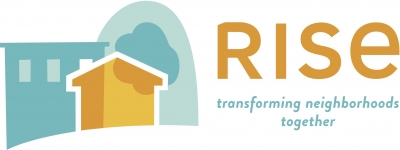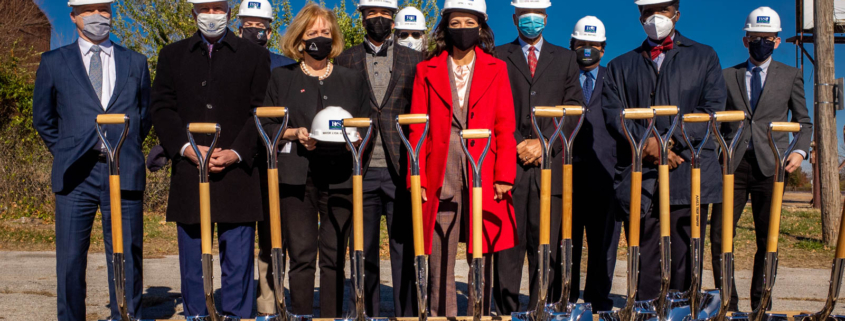Forest Park Southeast Update Keeps the Neighborhood Affordable
/in Real Estate Development, Rise News, Uncategorized /by Larry PerlmutterOn Wednesday, March 31, 2021, Rise and its partners Forest Park Southeast Development Corporation closed on the $11.5 Million dollar update of Park East Apartments in the Forest Park Southeast neighborhood. The project will also use state and federal historic tax credits and will result in an average of $40,000 per unit of rehabilitation of the 73 apartments affordable to families making 60% or less of the Area Median Income level. The scope of work includes new mechanical systems, roofs, flooring, new kitchen and bath finishes, paint, and some site work. We believe it is important that affordable housing be indistinguishable in quality, blend into and complement other new development in the area. We also believe stronger markets can support a wider mix of incomes and these intentional efforts to generate socioeconomic diversity. Here is a little bit of history concerning Rise’s previous work in the area: In 2001, Rise partnered with Forest Park Southeast Development Corporation (now under the umbrella of Park Central Development Corporation), to acquire 36 absentee-owned, poorly managed, and maintained rental properties, all located in a 3×4 block area of the neighborhood north of Manchester. The Rise partnership introduced professional property management and completed the complete historic rehab of 24 of the buildings as 73 affordable apartments (Park East Apartments) in 2003. In a complementary development, the Rise partnership completed the historic rehab and conversion of 11 of the remaining buildings into single-family market-rate homes (Park East Homes) in December 2004. Park East Homes bolstered the homeownership market in the neighborhood and further stabilized the area north of Manchester. The remaining mixed-use building that was acquired was sold to the owner of the business that had been a long-time tenant of the building. All 36 buildings are located within walking distance of the BJC/Washington University Medical Center campus. In 2006, again working with Forest Park Southeast Development Corporation, Rise completed the historic rehabilitation of another 13 buildings with 27 residences in the part of the neighborhood that lies north of Manchester, bringing us to a total to 48 historic rehab buildings in the neighborhood. Our work in Forest Park Southeast proved to be both catalytic and prophetic. In the following years, other developers began developing a wide variety of housing, including larger multi-family projects, mixed-use buildings, custom homes, and historic rehabilitation. St. Louis is a city of neighborhoods and Forest Park Southeast (FPSE) is currently one of its most dynamic. In recent years, FPSE has seen a dramatic rise in commercial and retail development (the area known as “the Grove”) and an improving residential real estate market. FPSE is situated at a nexus of growth in job opportunities not seen in many other parts of the metropolitan area. This part of St. Louis is now the third-largest job center in the region, behind only Downtown and Clayton, and it is projected to pass Clayton in the next few years. Congratulations to the team at Rise and our partners at Forest Park Southeast Development Corporation!
DOORWAYS 2.0 Groundbreaking – Windy and Wonderful
/in Events, Real Estate Development, Rise News, Uncategorized /by Larry PerlmutterWork Begins at Gene Slay’s Girls & Boys Club in Dutchtown
/in Rise News, Uncategorized /by Larry PerlmutterWork has begun on the Gene Slay’s Girls & Boys Club (GSGBC) Dutchtown Satellite in the former St. Hedwig’s School on Pulaski Street. The expansion of neighborhood organizations, faith groups, and local businesses to serve as safe places for youth was a priority during development of the Gravois Jefferson Historic Neighborhoods Plan. This project represents a step toward achieving that vision.
Neighborhood Plan
The Gravois Jefferson Historic Neighborhoods development plan covers the Benton Park West, Northeast Dutchtown, and Gravois Park neighborhoods. During the planning process, community members and leaders committed to improving the quality of life for young people living in the planning area. The plan includes strategies to break the cycle of poverty for youth through a “long-term, collaborative commitment from all sectors, including schools, government agencies, employers, and nonprofits.” The GSGBC will be a great addition to the neighborhood and standing symbol of that pledge.
The Gene Slay Girls and Boys Club
The mission of the GSGBC is to empower girls and boys in the St. Louis metropolitan area, especially those who are most in need, to realize their physical, intellectual, and emotional potential. The organization began serving St. Louis in 1929, taking on its current name in 2016. The GSGBC provides programs that meet the needs of at-risk youth through academics, leadership building, health, athletics, and the arts. You can donate to support their important work in south St. Louis.
Rise is serving as the development consultant for the project and provided support during the development of the neighborhood plan. Rise’s division for community planning offers a comprehensive approach to community development based on engagement with local residents and community leaders.
This important project has been made possible through the support of many community partners, volunteers, funders, and the City of St. Louis.
Learn More
Looking for more information regarding the Gravois Jefferson Historic Neighborhoods Plan? Feel free to contact us or visit https://gravoisjeffersonplanning.org/.
About Rise
Rise builds market rate and affordable housing, enhancing the quality of life in the communities we serve. This work helps make St. Louis a great place to live, work, and play. We believe social, cultural, lifestyle, and economic diversity makes area neighborhoods stronger.
Rise acts as a resource and partner to the community. We bring together nonprofit organizations, financial institutions, and government to make successful neighborhood revitalization possible.
Business Hours
Latest News
 Letter to Fairview Village ResidentsJune 29, 2023 - 6:20 pm
Letter to Fairview Village ResidentsJune 29, 2023 - 6:20 pm Information for Fairview Village Senior Living Apartments March 29, 2023 - 4:27 pm
Information for Fairview Village Senior Living Apartments March 29, 2023 - 4:27 pm Rick Bonasch, Beloved Colleague at Rise, Passes Peacefully at 63October 21, 2022 - 11:48 am
Rick Bonasch, Beloved Colleague at Rise, Passes Peacefully at 63October 21, 2022 - 11:48 am Rise YP Hosts the 2022 – 90s Trivia Night!August 16, 2022 - 10:41 am
Rise YP Hosts the 2022 – 90s Trivia Night!August 16, 2022 - 10:41 am Rise Spring NewsletterJune 23, 2022 - 10:30 am
Rise Spring NewsletterJune 23, 2022 - 10:30 am




